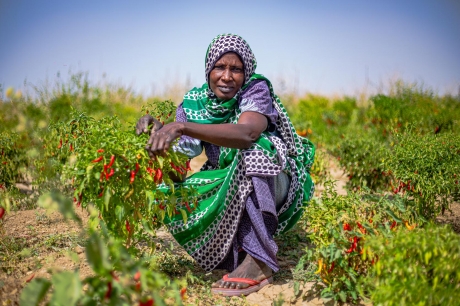
The Far North region of Cameroon is the setting of devastating floods that leave thousands homeless every year. In the department of Logone-et-Chari, the localities of Blangoua and Makary are among the most affected areas. Torrential rains and rising waters from the Logone, Chari, El Beid, Taf Taf and Serbowel rivers destroy homes and crops, jeopardizing people’s livelihoods and food security.
Over the course of the year, the damage caused by heavy rains and overflowing rivers ravaged a total of 48 464 hectares of fields and 41 278 homes in the Far North region, seriously impacting the living conditions of households who were left to fend for themselves. Like Saleh, 313 200 people were affected by flooding, according to the United Nations Office for the Coordination of Humanitarian Affairs.
In October 2022, when the Logone River rose due to excessive rains, the waters broke through the protective dykes in some areas. Saleh Youssouf, his wife and eight children were among the families forced to abandon their homes and crops, which promised good harvests. When the floods engulfed Saleh’s home and farm, his family had no choice but to find refuge on higher ground in Kinabari.

Saleh recounts with great emotion that these violent rains destroyed everything they had built. “Our huts collapsed before our eyes and our belongings were washed away by the waters,” he says.
It was during this time that the early warning system deployed by the Food and Agriculture Organization of the United Nations (FAO) showed a high risk of flooding in the Far North region. The anticipatory actions proved successful in mitigating a lot of the flood’s impacts.
With this alert system, populations exposed to agro-climatic risks are now better equipped to face future hazards.
“We are now more organized, more prepared for the occurrence of a crisis, we no longer panic as was the case before,” says Abaicho Abakar, President of the Committee for Preparation and Response of the Blangoua region.
In the long term, the project plans to take this anticipatory action initiative to other communes in Cameroon.
Relocated to Kinabari, Saleh and his family received more than one hectare of land from Blama, the head of the neighbourhood. FAO provided him with onion seeds and an agricultural kit consisting of hoes, machetes, sprayers and shovels to enable him to resume his agricultural activities.
Saleh says fondly that the help he received gave him “the courage to make a fresh start.”
“Today we harvest part of my plot. My onions sell for a very good price because they are of better quality than what is found on the market,” he says.
In situations like the October 2022 floods, where anticipation and contingency aren’t enough, FAO has established response plans to help communities get back on their feet and restart their livelihoods as quickly as possible.
Since 2021, FAO has been improving the anticipatory action and emergency response system in Cameroon, analysing the food and nutrition security impacts of humanitarian crises. Funded by the Directorate-General for European Civil Protection and Humanitarian Aid Operations (ECHO), this project helps governments and communities better prepare, anticipate, analyse and make decisions ahead of a crisis.
In October 2022, the project activated the distribution of assistance through four pre-positioned contingency stock warehouses filled with food, tools and other essential items, in each community (Blangoua, Makary, Koza and Mora). FAO also provided 6 000 bags that the communities filled with sand to make protective dykes ahead of the flooding.
The project also helped establish different community preparation and response bodies. These groups work directly with the people at risk, reporting on relaying information on potential crises. Ahead of the floods, these committees helped the communities organize the filling of sandbags and constructing the dykes. Like Saleh, several flood victims say that the project’s support in terms of inputs, seeds, agricultural emergency kits and other tools, as well as the on-the-ground monitoring provided by FAO, has greatly contributed to improving their living conditions.
Dandi Eloi Ganaf, Sub-Prefect of the commune of Blangoua, explains that FAO helped the people of Blangoua to get out of the difficult situation in which they found themselves after the floods. “Thanks to FAO, the district of Blangoua is now part of the onion production basins in the Far North region,” Ganaf states with great joy.
Agbassi Adoum, Mayor of Makary commune, said, “FAO has brought such great hope that these people have smiled again.” He concludes: “It was not enough to give them clothes and food, but to make them independent by giving them seeds to work their own fields. That’s what FAO did!”
Source: the FAO News and Media office, Rome





